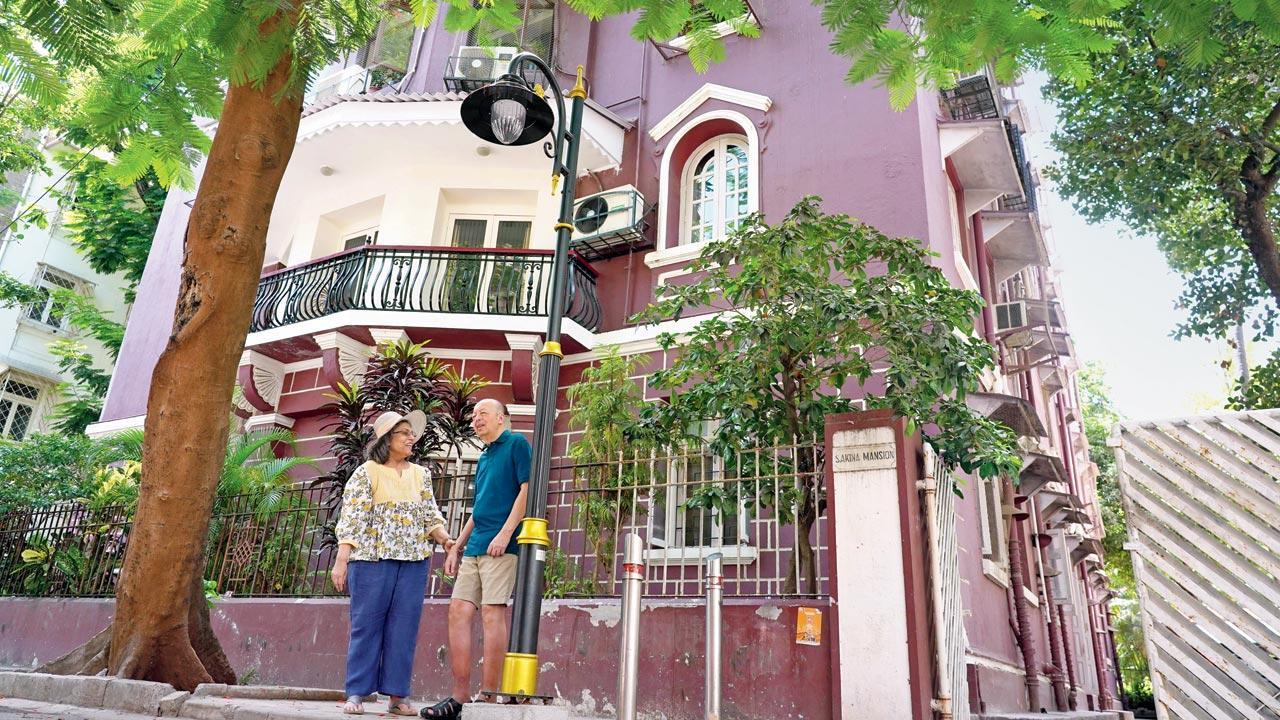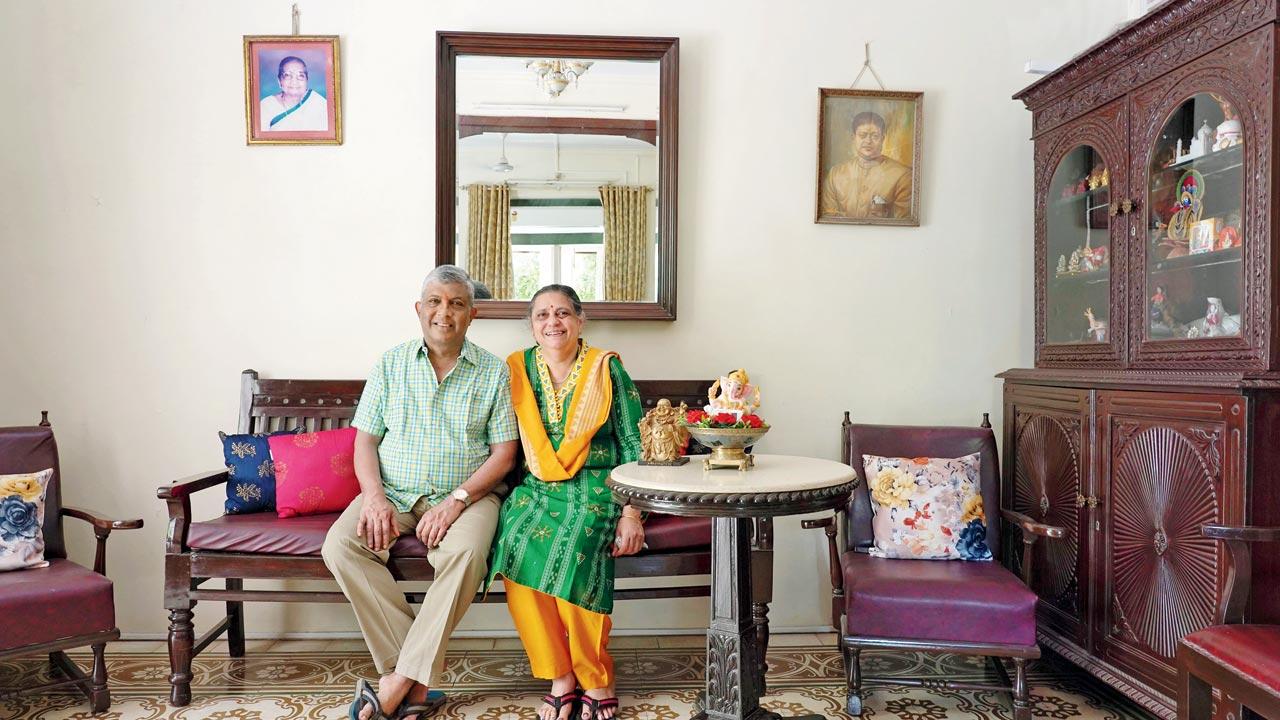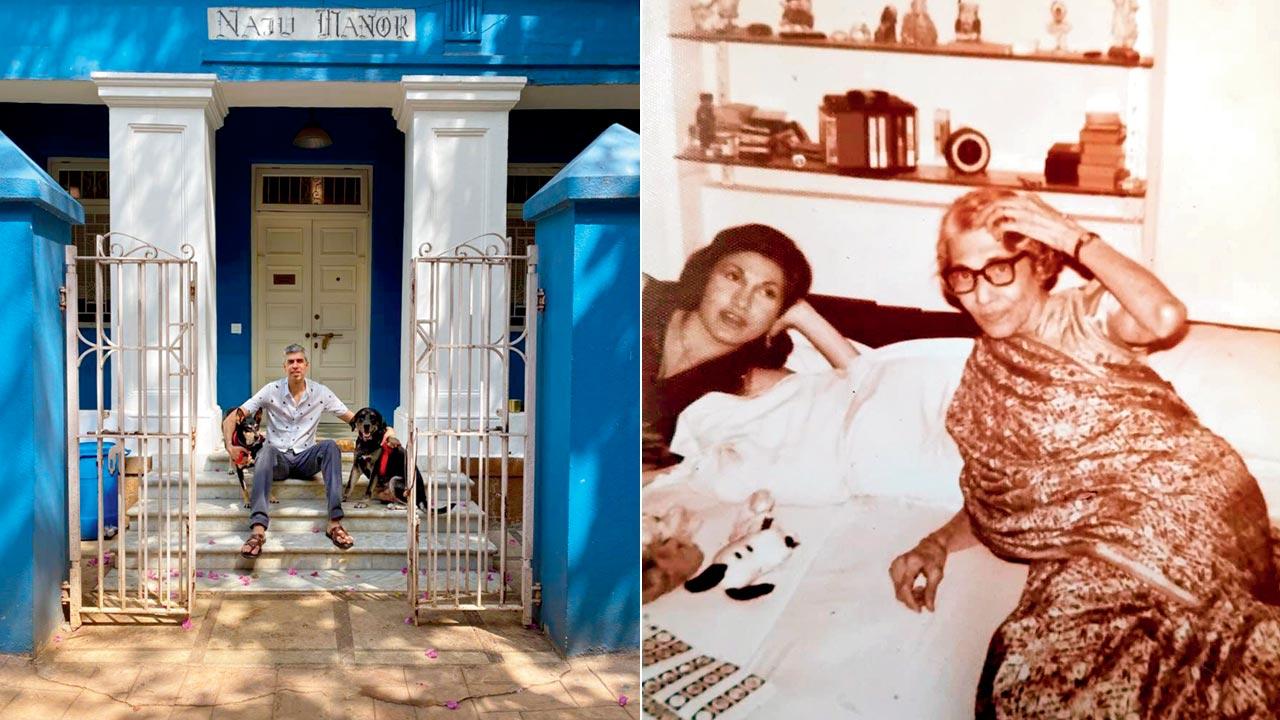Oliver Street, the little Colaba lane lined with artistically designed buildings, leaves us guessing about its name

Nina and Vinod Malkani of Sakina Mansion
 Most toddlers have their height measured with colourful charts. Mine marked theirs against tender green Christmas tree boughs. Eager to check how tall they stretched, every few months they stood beside a tiny potted tree—eventually replanted in a park. Each one’s first birthday present from my husband’s aunt, Perin Rustomjee. “They’ll have fun shooting up inches with the baby tree,” she wrote in a note.
Most toddlers have their height measured with colourful charts. Mine marked theirs against tender green Christmas tree boughs. Eager to check how tall they stretched, every few months they stood beside a tiny potted tree—eventually replanted in a park. Each one’s first birthday present from my husband’s aunt, Perin Rustomjee. “They’ll have fun shooting up inches with the baby tree,” she wrote in a note.
ADVERTISEMENT
When I went to personally thank her for the thoughtfulness, I fell in love with the Colaba lane she lived on. Oliver Street, lined with half-a-dozen quietly elegant, four-storey buildings of mixed architectural design with striking grilles, windows and embellished reliefs. Most of their names have changed with successive landlords. More, later, on how the road could have got its name.
Perin Rustomjee warmly welcomed strangers and friends alike, at Naju Manor. Her daughter Nazneen says, “This wasn’t only because she grew a garden blooming with bougainvillea, roses, and pink and white mussaenda. She loved children. She loved nature. Watching her nurture plants with care drew passersby to our gate.
 Dr Harshad Vijaykar and wife Ashwini in Salma Manzil
Dr Harshad Vijaykar and wife Ashwini in Salma Manzil
Underprivileged kids stopped curiously at the bricked flowerbeds she was always bent over. Asked what she was doing, she gave them a hose pipe to water with. It was constructive fun. Those kids became companions Shiraz and I played with in summer holidays.”
Nazneen’s brother Shiraz adds, “This was a sleepy lane in the mid-’70s. The silence was cut by the sounds of itinerant vendors practising their trade, everyone from the topli paneer hawker to the cotton carder twanging his dhunki instrument. It was pretty and peaceful.” Too peaceful, according to a neighbour remembering the “deathly quiet” that drove her running out to Colaba Causeway for just a bit of bustle.
Checking in at Bentley’s Hotel, located on two levels of Naju Manor, when he wanders south from his Madh Island digs, photographer Hemant Chaturvedi observes: “Most buildings on Oliver Street pre-date Regal Theatre [1933], making it interesting to see how initial traces of Art Deco had already crept in. Naju Manor has a beautiful Art Deco gate in an otherwise largely modern colonial structure. Plenty of foreigners choose the guesthouses in these old buildings over regular hotels.”
 Khursheed Narang at Jer Manzil. Pics/Aditi Haralkar
Khursheed Narang at Jer Manzil. Pics/Aditi Haralkar
A fair number of locals also opted for accommodation at these guesthouses. Englishman Arthur Joseph Bentley’s establishment opened soon after Naju Manor, Jer Manzil and Collet House (Sakina Mansion today) were erected between 1930 and 1932. Once spread over bunches of flats in these three buildings, Bentley’s currently operates from two floors of Naju Manor.
“The concept of ‘residential’ has changed a lot,” says Bentley’s proprietor Homi Kaka. “Booked monthly or yearly, guesthouse accommodation, comprising two rooms with a kitchen, was quite commonly used as a temporary home by some customers.” Theatre actors Scheherazade and Rohinton Mody lived from the ’70s to the ’90s in such a space of the hotel in Naju Manor, where their mentor Adi Marzban and his wife Silla would drop in, especially for Sunday lunch.
Jer Manzil, the gorgeously Georgian building facing Naju Manor, housed another pair of floors for Bentley’s. “In the pre-Partition years, the buildings on this street were owned by Parsis. My Karachi-born father, Noshir Dinshaw Sidhva, came to Jer Manzil around 1945. His uncle, Nadirshaw Sidhva, and Nadirshaw’s son, Minoo, the original Port Trust tenants, built it in 1930,” says Khursheed Narang, as she takes me through the compound. We gaze up to admire exquisite stained-glass panels on first and second-floor balconies glinting in shafts of fierce sun. A visionary who took Grindwell Norton Limited soaring as India’s leading manufacturer of abrasives and silicon carbide, Noshir Sidhva steered the company (co-founded by his uncle PH Sidhwa) for decades as vice-chairman and managing director. “Resident families like ours were issued a pass from the Port Trust to enter its garden behind Jer Manzil,” Narang adds.
 Shiraz Rustomjee on the steps of Naju Manor with his dogs Rosie and Grey; (right) Adi Marzban’s 1970s photo of his wife Silla (right) with actress Scheherazade Mody in Naju Manor
Shiraz Rustomjee on the steps of Naju Manor with his dogs Rosie and Grey; (right) Adi Marzban’s 1970s photo of his wife Silla (right) with actress Scheherazade Mody in Naju Manor
Sharing a wall with Jer Manzil and adorned with delightful swathes of hybrid architectural highlights on the facade, Sakina Mansion was once Collet House. It was constructed in 1932 by lawyer Pestonji Paruk, whose books, The Indian Succession Act and The Indian Arbitration Act, became classic texts. Collet was the name of the firm he earlier worked at, before joining Mulla & Mulla.
Paruk’s granddaughter, veteran journalist and social activist Meher Pestonji, hosted sparkling soirees on her fourth-floor terrace. They gathered together performers, poets, painters and printmakers, from Satyadev Dubey, Shabana Azmi, Govind Nihalani and Pearl Padamsee, to Imtiaz Dharker, Nissim Ezekiel and Jeet Thayil, to Akbar Padamsee and Bharati Kapadia. Besides the stimulating buzz at the alfresco adda, Pestonji kept paying guests from the writing world. They included Dilip Thakore, founder editor of Business World and Business India magazines, Hutokshi Doctor and Geeta Vasudevan.
Her apartment was never a hub for the cognoscenti alone. It often doubled as a safe haven for victims of injustice or violence such as the riot-scarred refugees of 1992-93. She recounts sadly that most neighbours and friends were unwilling to help her bring them home to shelter from affected areas, mainly Dharavi and Govandi.
On a cheerier note, she says, “Growing up on this road, I was forever up to madness with my friends, Lesley, Shireen and Niti. We dressed in crazy disguises, went house to house selling craft items we created for causes we supported. And we tore away on cycles to Navy Nagar, then known as Duxbury. Swinging on trees in the BPT garden next door, a branch broke off. The angry maali went to all four homes with the severed branch to complain to each set of parents.”
In their cosy second-floor apartment in Sakina Mansion, Nina and Vinod Malkani point to a Buddha statue received from Meher Pestonji as a goodbye gift when she moved to Bandra. Malkani’s father came here in 1962. Badminton champion Frene Talyarkhan lived below them, where the Tambawala family does now. On the ground floor was tuition teacher Tehmi Kothavala, whose son-in-law Jimmy Guzdar was a sub-broker associated with the Malkanis’ firm, Jagvin Investments. “Theirs was the home we most frequented—kind Aunty Tehmi and Uncle Polly invited us for delicious Parsi dinners,” says Vinod.
A slant across, Salma Manzil was Lalchand Building, which was first called Nakra House. Vinod’s brother Jagdish remembers maverick poet-copywriters Kersy Katrak and Arun Kolatkar pace in and out of this first of three office addresses for MCM (Mass Communication and Marketing), Katrak’s agency which turned around Indian advertising forever. What Jagdish recollects more clearly is: “The road was a honeypot, with exceptionally attractive young ladies everywhere. Boys played hand-ball and French cricket, batting in any direction to get a glimpse of girls like the three daughters of the Coates in Salma Manzil, the sisters Christine and Julia in Sakina Mansion. They all left for England eventually.”
From 1930, when these buildings rose, till about the 1980s, the lane was predominantly occupied by Parsis, Bohri Muslims, Englishmen, Anglo Indians and Jews. The Salma Manzil home of hospitable Moses Sultoon, Chairman of the Sassoon Trusts, saw him engage with a stream of Baghdadi Jew visitors, the actress Nadira from Nagpada among them. He was respected for attending to the concerns of his community with patient attention.
Across the landing from Sultoon’s one-time residence, I meet a Pathare Prabhu family with three generations of doctors. Between sips of cooling panna which his wife Ashwini whips up on the scorcher of a May morning, I listen to Dr Harshad Vijaykar, a dentist, narrate his story. His father, general physician, Dr Narayan Vijaykar, and gynaecologist mother, Dr Nalini Vijaykar, came to Salma Manzil in 1952, when it was called Nakra House. “They were both very well-known doctors in Girgaum. My mother had a clinic there as well as one in Colaba. Our son Ameya is a GP and daughter Apurva is a dentist working with me. They carry on the medical legacy. We have other examples of continuity. This baakda, the wooden bench we are sitting on, which is over 80 years old, is from my clinic. Well-preserved furniture is a matter of pride.”
Though probably the road’s oldest residents, even the Vijaykars leave unanswered the question we must circle back to. Who was the Oliver gracing the street signboard? There is no reference to him in Samuel Sheppard’s book, Bombay Place Name and Street Names. Old maps assign varied ideas. A basin at the location, called Oliver’s Folly, seems to have held a coal depot and an 1866 illustration does show coal sheds. An 1887 map indicates a BB&CI Railway wharf at the spot. Conferring with Bombayphiles like Vinayak Talwar and Deepak Rao leaves us in a swirl of possibilities and debatable initials. BPT: might Oliver have been an officer of the Port Trust whose land is marked by this grid of leafy lanes? BIT: Was he from the Bombay Improvement Trust? BB&CI: Or perhaps the Railways?
We hope to have some more light thrown on the elusive Oliver. Much like the (as yet unknown) gent’s famed Dickensian namesake asked—albeit in a completely different context—I request better-informed readers, “Please, sir, I want some more.”
Author-publisher Meher Marfatia writes fortnightly on everything that makes her love Mumbai and adore Bombay. You can reach her at meher.marfatia@mid-day.com/www.meher marfatia.com
 Subscribe today by clicking the link and stay updated with the latest news!" Click here!
Subscribe today by clicking the link and stay updated with the latest news!" Click here!







